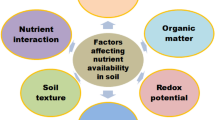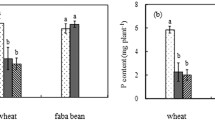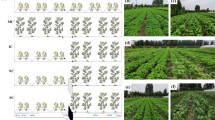Abstract
Rhizosphere processes of individual plants have been widely investigated since 1904 when the term “rhizosphere” was first put forward. However, little attention has been paid to rhizosphere effects at an agro-ecosystem level. This paper presents recent research on the rhizosphere processes in relation to plant nutrition in main cropping systems in China. In the peanut (Arachis hypogaea L.)/maize (Zea mays L.) intercropping system, maize was found to improve the Fe nutrition of peanut through influencing its rhizosphere processes, suggesting an important role of phytosiderophores released from Fe-deficient maize. Intercropping between maize and faba bean (Vicia faba L.) was found to improve nitrogen and phosphorus uptake in the two crops compared with corresponding sole crop. There was a higher land equivalent ratio (LER) in the intercropping system of maize and faba bean than the treatment of no root interactions between the two crops. The increased yield of maize intercropped with faba bean resulted from an interspecific facilitation in nutrient uptake, depending on interspecific root interactions of the two crops. In the rotation system of rice (Oryza sativa L.)-wheat (Triticum aestivum L.) crops, Mn deficiency in wheat was caused by excessive Mn uptake by rice and Mn leaching from topsoil to subsoil due to periodic cycles of flooding and drying. However, wheat genotypes tolerant to Mn deficiency tended to distribute more roots to deeper soil layer and thus expand their rhizosphere zones in the Mn-deficient soils and utilize Mn from the subsoil. Deep ploughing also helped root penetration into subsoil and was propitious to correcting Mn deficiency in wheat rotated with rice. In comparison, oilseed rape (Brassica napus L.) took up more Mn than wheat through mobilizing sparingly soluble soil Mn due to acidification and reduction processes in the rhizosphere. Thus, oilseed rape was tolerant to the Mn-deficient conditions in the rice-oilseed rape rotation. Oxidation reactions on root surface of rice also resulted in the formation of Fe plaque in the rice rhizosphere. Large amounts of Zn were accumulated on the Fe plaque. Zinc uptake by rice plants increased as Fe plaque formed, but decreased at high amounts of Fe plaque. It is suggested that to fine-tune cropping patterns and optimize nutrient management based on a better understanding of rhizosphere processes at an agro-ecosystem level is crucial for increasing nutrient use efficiency and developing sustainable agriculture in China.
Similar content being viewed by others
References
Ae N, Rihara J, Okada K, Yoshihara T and Johansen C 1990 Phos-phorus uptake by pigeon pea and its role in cropping systems of Indian Subcontinent. Science 248, 477–480.
Armstrong W 1967 The oxidizing activity of roots in waterlogged soils. Physiol. Plant. 20, 540–543.
Aulakh M S, Khera T S, Doran J W and Bronson K F 2001 Man-aging crop residue with green manure, urea, and tillage in a rice-wheat rotation. Soil Sci. Soc. Am. J. 65, 820–827.
Bohringer A and Leihner D E 1997 A comparison of alley cropping and block planting systems in sub-humid Benin. Agrofor. Syst. 35, 117–130.
Boucher D H and Espinosa J 1982 Cropping system and growth and nodulation responses of beans to nitrogen in Tabasco, Mexico. Trop. Agric. (Trinidad) 59, 279–282.
Braconnier S 1998 Maize-coconut intercropping: effects of shade and root competition on maize growth and yield. Agronomie 18, 373–382.
Bryan G and Hopking B 1992 Plant utilization of iron solubilized by oat phytosiderophore. J. Plant Nutr. 15, 1599–1612.
Callaway R M and Pugnaire F I 1999 Facilitation in plant com-munity. In Handbook of Functional Plant Ecology. Ed. F I Pugnaire. pp. 623–648. Marcel Dekker, New York.
Dauro D and Mohamedsaleem M A 1995 Shoot and root interac-tions in intercropped wheat and clover. Tropic Agric (Trinidad) 72, 170–172.
Dupraz C, Simorte V, Dauzat M, Bertoni G, Bernadac A and Masson P 1998 Growth and nitrogen status of young walnuts as affected by intercropped legumes in a Mediterranean climate. Agrofor. Syst. 43, 71–80.
Ellis E C and Wang S M 1997 Sustainable traditional agriculture in the Tai Lake Region of China. Agric. Ecosyst. Environ. 61, 177–193.
Fang Z 1998 Mechanisms on tolerance to Mn deficiency by different genotypes of wheat and oilseed rape. Ph.D. Dissertation, China Agricultural University (in Chinese), Beijing.
Gami S K, Ladha J K, Pathak H, Shah M P, Pasuquin E, Hobbs P R, Joshy D and Mishra R 2001 Long-term changes in yield and soil fertility in a twenty-year rice-wheat experiment in Nepal. Biol. Fertil. Soils 34, 73–78.
Harrington L 2000 Synthesis of systems diagnosis: ‘Is the sus-tainability of the rice-wheat cropping system threatened?’ – An epilogue. J. Crop. Prod. 3, 119–132.
Helenius J and Jokinen K 1994 Yield advantage and competition in intercropped oats (Avena sativa L.) and faba bean (Vicia faba L.): application of the hyperbolic yield-density model. Field Crops. Res. 37, 85–94.
Hopking B G, Jolley V D and Brown J C 1992 Differential response of Fe-inefficient muskmelon, tomato, and soybean to phytosiderophore released by Coker 227 oat. J. Plant Nutr. 15, 35–48.
Horst W J and Waschkies Ch 1987 Phosphatversorgung von Sommer-weizen (Triticum aestivum L.) in Mischkultur mit weis-ser Lupine (Lupinus albus L.). Z. Pflanzenerahr. Bodenk. 150, 1–8.
Jolliffe P A and Wanjau F M 1999 Competition and productivity in mixtures: some properties of productive intercrops. J. Agric. Sci. (Cambridge) 132, 425–435.
Kirk G J D and Bajita J B 1995 Root-induced iron oxidation, pH changes and zinc solubilization in the rhizosphere of lowland rice. New Phytol. 131, 129–137.
Kumar A and Yadav D S 2001 Long-term effects of fertilizers on the soil fertility and productivity of a rice-wheat system. J. Agron. Crop Sci. 86, 47–54.
Li L, Yang S C, Li X L, Zhang F S, and Chriestie P 1999 In-terspecific complementary and competitive interaction between intercropped maize and faba bean. Plant Soil 202, 105–114.
Li L, Sun J H, Zhang F S, Li X L, Yang S C and Rengel Z 2001 Wheat/maize or wheat/soybean strip intercropping. I. Yield ad-vantage and interspecific interactions on nutrients. Field Crops. Res. 71, 123–137.
Li L, Zhang F S, Li X L, Christie P, Yang S C and Tang C 2003 In-terspecific facilitation of nutrient uptakes by intercropped maize and faba bean. Nutr. Cycl. Agroecosys. 65, 61–71.
Liu X H 1994 Tillage Science. China Agricultural University, Beijing.
Liu X J 1997 Mechanisms and prevention strategy of manganese deficiency in wheat on soils with rice-wheat rotation in Sichuan Province. Ph.D. Dissertation, China Agricultural University, Beijing.
Liu X J, Lu S H, Zhang F S and Mao Daru 1999a Effect of Water and Fertilization on Movement of Manganese in soils and on Its Uptake by Rice. Acta Pedologica Sinica 36: 369–376.
Liu X J, Lu S H, Zhang F S and Mao D R 1999b Effect of Mn ap-plication depth on Mn deficiency of two wheat genotypes. China J. Applied Ecol. 10, 179–182.
Liu X J, Liao X Y, Zhang Y Z, Zhang F S and Huang Y X 2002 Effects of Rice-based cropping system on distribution of man-ganese in the profile of paddy soil derived from red earth. Acta Ecol. Sinica 22, 1440–1445.
Lu S H 1992 Soil manganese and application of manganese fertilizer under condition of rice-wheat rotation. J. Sichuan Agri. Univ. 10, 75–79.
Lu S H, Zeng X Z, Liu X J and Zhang F S 2002 Effects of root penetration restriction on growth and Mn nutrition of different winter wheat genotypes in paddy soils. Agri. Sci. China 1, 667–673.
Lu S H, Liu X J, Li L, Zhang F S, Zeng X Z and Tang C X 2004 Effect of manganese spatial distribution in soil profile on wheat growth in rice-wheat rotation. Plant Soil (in press).
Marschner H 1995 Mineral Nutrition in Higher Plants. Academic Press, London.
Marschner H, Treeby M and Römheld V 1989 Role of root-induced change in the rhizosphere for iron acquisition in higher plants. Z. Pflanzenernahr. Bodenkd. 152, 197–204.
Midmore D J 1993 Agronomic modification of resource use and intercrop productivity. Field Crops. Res. 34, 357–380.
Nayyar V K, Sadana U S and Takkar T N 1985 Methods and rates of application of Mn and its critical levels for wheat following rice on coarse textured soils. Fert. Res. 8, 173–178.
Piepho H P 1995 Implications of a simple competition model for the stability of an intercropping system. Ecol. Model. 80, 251–256.
Ponnamerperuma F N 1972 The chemistry of submerged soils. Adv. Agron. 24, 29–96.
Römheld V 1991 The role of phytosiderophores in acquisition of iron and other micronutrients in graminaceous species: An ecological approach. Plant Soil 130, 27–134.
Rovira A D 1991 Rhizosphere research-85 years of progress and frustration. In The rhizosphere and plant growth. Eds. D L Keister and P B Cregan. pp. 3–13. Kluwer Academic Publishers.
Singh A K, Amgain L P and Sharma S K 2000 Root characteristics, soil physical properties and yield of rice (Oryza sativa) as influ-enced by integrated nutrient management in rice-wheat (Triticum aestivum) system. Indian J. Agron. 45, 217–222.
Stern W R 1993 Nitrogen fixation and transfer in intercrop systems. Field Crops. Res. 34, 335–356.
Timsina J and Connor D J 2001 Productivity and management of rice-wheat cropping systems: issues and challenges. Field Crops. Res. 69, 93–132.
Tong P Y 1994 Achievements and perspectives of tillage and cropping system in China. Cropping system and cultivated technology. (in Chinese) 77, 1–5.
Vandermeer J H 1989 The Ecology of Intercropping. Cambridge University Press.
Wang J 2001 Crop yields and nutrient dynamics impacted by dif-ferent mulching styles in upland rice/wheat rotation systems. Ph.D. Dissertation, China Agricultural University, Beijing. (in Chinese)
Whipps J M and Lynch J M 1986 The influence of the rhizosphere on crop productivity. Adv. Microb. Ecol. 9, 187–244.
Willey R W1979 Intercropping – its importance and research needs. Part 1. Competition and yield advantages. Field Crop Abstr. 32, 1–10.
Zhang F and Li L 2003 Using competitive and facilitative interac-tions in intercropping systems enhances crop productivity and nutrient-use efficiency. Plant Soil 248, 305–312.
Zhang F and Shen J 1999a Progress in plant nutrition and rhizo-sphere research. In Research Progress in Plant Protection and Plant Nutrition. Ed. China Agronomy Society. pp. 458–469. China Agriculture Press, Beijing.
Zhang F and Shen J 1999b The preliminary development of the theoretical concept of rhizosphere ecosystem and its research emphasis. J. China Agri. Sci. Technol. 4, 15–20.
Zhang F, Li L and Sun J 2001 Contribution of above-and below-ground interactions to intercropping. XIV International Plant Nutrition Colloquium, 27 July – 3 August 2001, Hannover, Germany.
Zhang F, Shen J and Zhu Y 2002 Nutrient Interactions in Soil-Plant Systems. In Encyclopedia of Soil Science. Ed. Rattan Lal. pp. 885–887, Marcel Dekker, Inc. New York.
Zhang X K, Zhang F S and Mao D R 1998 Effect of iron plaque outside roots on nutrient uptake by rice (Oryza sativa L.). Zinc uptake by Fe-deficient rice. Plant Soil 202, 33–39.
Zhang X K, Zhang F S and Mao D R 1999 Effect of iron plaque outside roots on nutrient uptake by rice (Oryza sativa L.): Phosphorus uptake. Plant Soil 209, 187–192.
Zuo Y, Zhang F, Li X and Cao Y 2000 Studies on the improve-ment in iron nutrition of peanut by intercropping with maize on a calcareous soil. Plant Soil 220, 13–25.
Author information
Authors and Affiliations
Rights and permissions
About this article
Cite this article
Zhang, F., Shen, J., Li, L. et al. An overview of rhizosphere processes related with plant nutrition in major cropping systems in China. Plant and Soil 260, 89–99 (2004). https://doi.org/10.1023/B:PLSO.0000030192.15621.20
Issue Date:
DOI: https://doi.org/10.1023/B:PLSO.0000030192.15621.20




